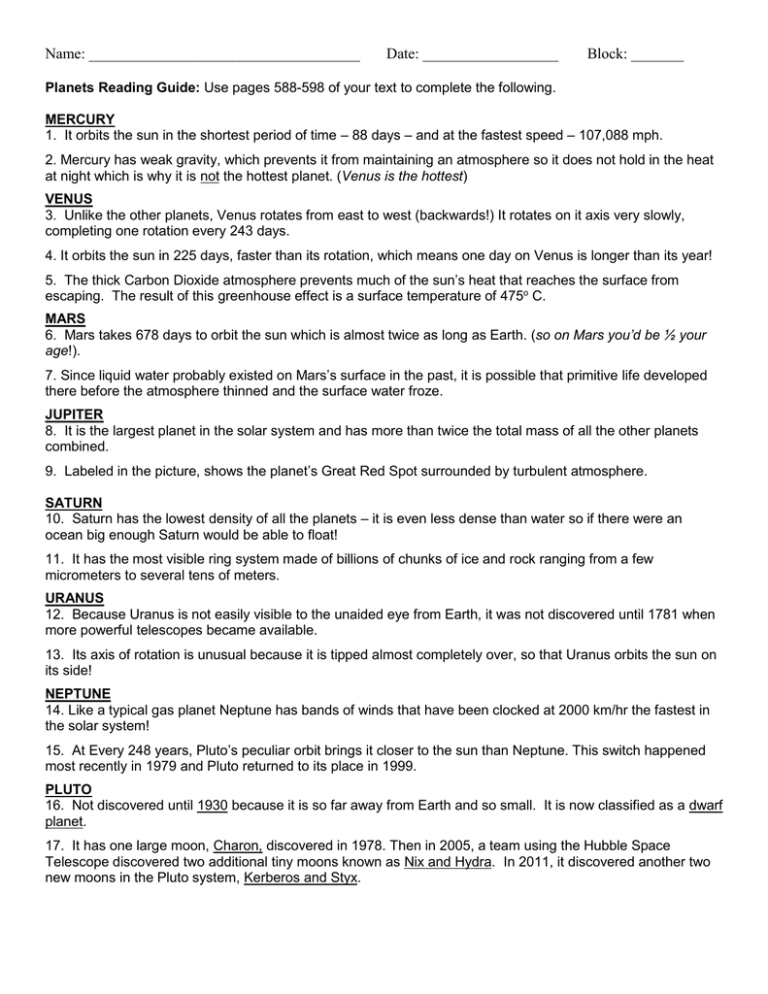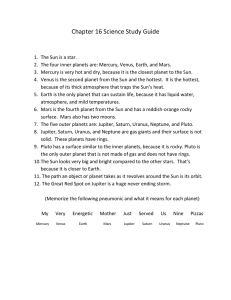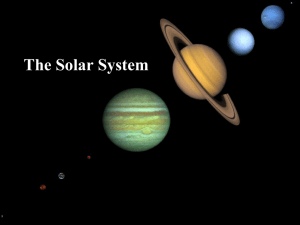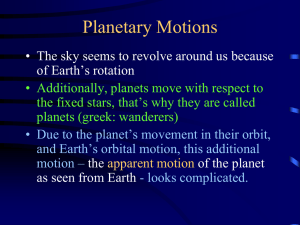Name: ____________________________________ Date: __________________
advertisement

Name: ____________________________________ Date: __________________ Block: _______ Planets Reading Guide: Use pages 588-598 of your text to complete the following. MERCURY 1. It orbits the sun in the shortest period of time – 88 days – and at the fastest speed – 107,088 mph. 2. Mercury has weak gravity, which prevents it from maintaining an atmosphere so it does not hold in the heat at night which is why it is not the hottest planet. (Venus is the hottest) VENUS 3. Unlike the other planets, Venus rotates from east to west (backwards!) It rotates on it axis very slowly, completing one rotation every 243 days. 4. It orbits the sun in 225 days, faster than its rotation, which means one day on Venus is longer than its year! 5. The thick Carbon Dioxide atmosphere prevents much of the sun’s heat that reaches the surface from escaping. The result of this greenhouse effect is a surface temperature of 475o C. MARS 6. Mars takes 678 days to orbit the sun which is almost twice as long as Earth. (so on Mars you’d be ½ your age!). 7. Since liquid water probably existed on Mars’s surface in the past, it is possible that primitive life developed there before the atmosphere thinned and the surface water froze. JUPITER 8. It is the largest planet in the solar system and has more than twice the total mass of all the other planets combined. 9. Labeled in the picture, shows the planet’s Great Red Spot surrounded by turbulent atmosphere. SATURN 10. Saturn has the lowest density of all the planets – it is even less dense than water so if there were an ocean big enough Saturn would be able to float! 11. It has the most visible ring system made of billions of chunks of ice and rock ranging from a few micrometers to several tens of meters. URANUS 12. Because Uranus is not easily visible to the unaided eye from Earth, it was not discovered until 1781 when more powerful telescopes became available. 13. Its axis of rotation is unusual because it is tipped almost completely over, so that Uranus orbits the sun on its side! NEPTUNE 14. Like a typical gas planet Neptune has bands of winds that have been clocked at 2000 km/hr the fastest in the solar system! 15. At Every 248 years, Pluto’s peculiar orbit brings it closer to the sun than Neptune. This switch happened most recently in 1979 and Pluto returned to its place in 1999. PLUTO 16. Not discovered until 1930 because it is so far away from Earth and so small. It is now classified as a dwarf planet. 17. It has one large moon, Charon, discovered in 1978. Then in 2005, a team using the Hubble Space Telescope discovered two additional tiny moons known as Nix and Hydra. In 2011, it discovered another two new moons in the Pluto system, Kerberos and Styx.




